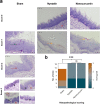Curcumin nanoparticles: the topical antimycotic suspension treating oral candidiasis
- PMID: 36100802
- PMCID: PMC10020268
- DOI: 10.1007/s10266-022-00742-4
Curcumin nanoparticles: the topical antimycotic suspension treating oral candidiasis
Abstract
Phytotherapeutics is widely used nowadays as an alternative to the current antifungal drugs to reduce their side effects. Curcumin, with its wide therapeutic array as antioxidant and anti-inflammatory agent, is one of the natural compounds that ha..s an antifungal effect, especially when being used at nanoscale to increase its bioavailability. Our research aimed to evaluate clinically and microbiologically the effect of using topical nanocurcumin suspension to treat oral candidiasis. After 4 days from induction of oral candidiasis (baseline), we randomly divided 39 female BALB/c mice into three groups of 13 animals; nanocurcumin, nystatin, and sham groups. All animals in nanocurcumin and nystatin groups received topical treatment twice daily for 10 days. Then, we performed clinical and microbiological evaluations at baseline, day 5, and day 10. By the end of treatment, our results revealed that nanocurcumin promoted a significant reduction in the number of candida colonies. There was no statistically significant difference neither clinically nor microbiologically between nanocurcumin and nystatin groups. In conclusion, nanocurcumin has a good antifungal effect as nystatin, however, its therapeutic efficacy takes a longer time to appear than nystatin. The enhanced bioavailability of curcumin at the nanoscale qualifies this nano-herb as a promising alternative therapy for oral candidiasis, evading nystatin-associated morbidity.
Keywords: Nanocurcumin; Nanotechnology; Nystatin; Oral candidiasis.
© 2022. The Author(s).
Conflict of interest statement
The authors declare that they have no conflict of interests.
Figures




Similar articles
-
Oropharyngeal candidiasis in patients with AIDS: randomized comparison of fluconazole versus nystatin oral suspensions.Clin Infect Dis. 1997 Jun;24(6):1204-7. doi: 10.1086/513664. Clin Infect Dis. 1997. PMID: 9195083 Clinical Trial.
-
Synergistic effect of thymoquinone and nystatin in the treatment of oral candidiasis; an in vitro study.Odontology. 2022 Apr;110(2):330-337. doi: 10.1007/s10266-021-00667-4. Epub 2021 Oct 17. Odontology. 2022. PMID: 34657217 Free PMC article.
-
Nystatin nanosizing enhances in vitro and in vivo antifungal activity against Candida albicans.J Antimicrob Chemother. 2013 Sep;68(9):2099-105. doi: 10.1093/jac/dkt137. Epub 2013 Apr 25. J Antimicrob Chemother. 2013. PMID: 23620465
-
Efficacy of photodynamic therapy in the treatment of oral candidiasis: a systematic review and meta-analysis.BMC Oral Health. 2023 Oct 26;23(1):802. doi: 10.1186/s12903-023-03484-z. BMC Oral Health. 2023. PMID: 37884914 Free PMC article.
-
Use of nystatin and chlorhexidine in oral medicine: Properties, indications and pitfalls with focus on geriatric patients.Gerodontology. 2017 Sep;34(3):291-298. doi: 10.1111/ger.12278. Epub 2017 May 29. Gerodontology. 2017. PMID: 28556195 Review.
Cited by
-
Applications of Curcumin and Its Nanoforms in the Treatment of Cancer.Pharmaceutics. 2023 Aug 29;15(9):2223. doi: 10.3390/pharmaceutics15092223. Pharmaceutics. 2023. PMID: 37765192 Free PMC article. Review.
-
Potential of Curcumin in the Management of Skin Diseases.Int J Mol Sci. 2024 Mar 23;25(7):3617. doi: 10.3390/ijms25073617. Int J Mol Sci. 2024. PMID: 38612433 Free PMC article. Review.
-
New Perspectives about Relevant Natural Compounds for Current Dentistry Research.Life (Basel). 2024 Jul 29;14(8):951. doi: 10.3390/life14080951. Life (Basel). 2024. PMID: 39202693 Free PMC article. Review.
-
Animal models of oral infectious diseases.Front Oral Health. 2025 Apr 17;6:1571492. doi: 10.3389/froh.2025.1571492. eCollection 2025. Front Oral Health. 2025. PMID: 40351786 Free PMC article. Review.
-
Antifungal activity of green-synthesized curcumin-coated silver nanoparticles alone and in combination with fluconazole and itraconazole against Candida and Aspergillus species.Curr Med Mycol. 2023 Sep;9(3):38-44. doi: 10.22034/cmm.2023.345125.1456. Curr Med Mycol. 2023. PMID: 38361962 Free PMC article.
References
MeSH terms
Substances
LinkOut - more resources
Full Text Sources

